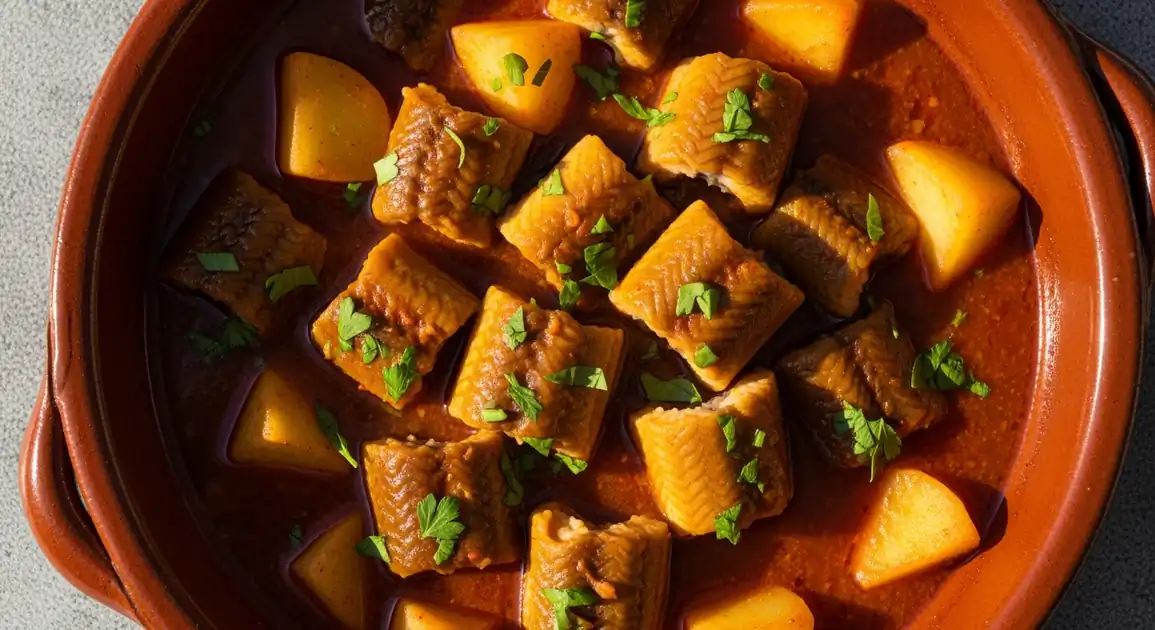All-i-pebre
All-i-pebre

Description
Valencia is the spiritual home of All-i-pebre, with the dish particularly significant in the city and surrounding areas, especially the Albufera Natural Park. In the capital city, you'll find both traditional versions in established restaurants and modern interpretations in contemporary establishments. For the most authentic experience, locals recommend venturing to El Palmar, a small village in the Albufera wetlands known for its eel dishes.
Dietary Information
Serving information
Serving style
Served in a traditional clay cazuela to maintain heat. Rustic bread is essential for soaking up the sauce. In more upscale restaurants, it might be presented with modern plating, but traditional serving in a cazuela is still common.
Quick facts
Lunch: 1:30 PM - 4 PM, Dinner: 8:30 PM - 11 PM. Note that restaurants in El Palmar may close earlier in the evening, especially on weekdays.
Safety Tips
What to Look For
-
Eel that is white to slightly pinkish when cooked
Properly cooked eel should have firm, opaque flesh. If it appears translucent, it may be undercooked.
-
Sauce with a rich, homogeneous texture
A good All-i-pebre sauce should be thick enough to coat the back of a spoon, indicating proper reduction and cooking time.
-
Dish served piping hot in a traditional clay cazuela
Ensures proper cooking temperature and maintains the traditional serving style that keeps the dish hot throughout the meal.
-
Restaurant displays knowledge about the source of their eel
Quality establishments will know if their eel is from Albufera, other Spanish waters, or farm-raised, indicating attention to ingredients.
What to avoid
-
Very fishy smell or gray-colored eel
Fresh eel should not have an overpowering fishy odor. Gray coloration could indicate old or poorly handled eel.
-
Watery or separated sauce
Indicates improper cooking technique or rushed preparation.
-
Undercooked or rubbery eel
Eel must be thoroughly cooked for both safety and texture reasons. It should flake easily when pressed with a fork.
-
Pre-prepared All-i-pebre that's merely reheated
The best versions are made to order or at least freshly prepared that day. Ask if in doubt.
Price information
Price range
Budget tips
- Prices in Valencia city center restaurants typically range from 18-30 EUR for a main course portion.
- Restaurants in El Palmar village often offer better value (16-25 EUR) despite specializing in the dish.
- Some restaurants offer a half portion ('media ración') at a reduced price.
- Family-run establishments often provide better value than touristy restaurants.
Value indicators
- Generous amount of eel (at least 4-5 substantial pieces).
- Homemade sauce with depth of flavor.
- Proper consistency (not too watery or too thick).
- Perfectly cooked potatoes that have absorbed the flavors.
- Complementary quality bread for soaking up sauce.
Where to Find This Dish
El Palmar
This village in the Albufera Natural Park is famous for its All-i-pebre. Most restaurants here specialize in the dish.
Albufera Lake, Traditional restaurants along main street
Weekend Lunch (reservations recommended)
El Cabanyal/Poblats Marítims
Valencia's traditional fishing neighborhoods offer authentic All-i-pebre in seafood restaurants.
Port area, Playa de la Malvarrosa
Lunch, Dinner
Ciutat Vella (Old Town)
Traditional Valencian restaurants in the historic center serve All-i-pebre, though often at higher prices.
Plaza de la Reina, Mercado Central, Barrio del Carmen
Lunch, Dinner
L'Eixample
More upscale and contemporary versions can be found in this sophisticated district.
Calle Colón, Gran Vía
Dinner
Vendor Tips
- In El Palmar, look for restaurants that have been established for generations.
- In Valencia city, restaurants displaying 'Cocina Tradicional Valenciana' certificates are more likely to serve authentic versions.
- Ask if they make their All-i-pebre with freshwater eel or an alternative fish.
- Some places require advance ordering for All-i-pebre, especially on weekends.
How to Order
Regional Variations
-
Traditional El Palmar Style
(All-i-pebre Estilo El Palmar)
The most authentic version, made with Albufera eel, featuring a thicker sauce with prominent garlic and paprika flavors.
-
Modern Valencian Interpretation
(All-i-pebre Moderno Valenciano)
Contemporary city restaurants sometimes offer lighter versions with less oil and a more refined presentation.
-
Seafood Restaurant Variation
(All-i-pebre de Marisquería)
Some seafood restaurants in Valencia blend traditional All-i-pebre techniques with other seafood influences.
-
All-i-pebre with Rice
(All-i-pebre con Arroz)
In some Valencia restaurants, particularly in El Palmar, you might find All-i-pebre sauce incorporated into rice dishes, creating a unique hybrid of the region's most famous cuisines.
Cultural context
History
All-i-pebre originated in the fishing communities surrounding Valencia's Albufera Lake, where freshwater eels were abundant. Dating back several centuries, it was a practical way for fishermen to prepare their catch using readily available ingredients. The dish represents the region's connection to both the sea and the fertile land around it. While traditionally a humble fisherman's meal, All-i-pebre has evolved into one of Valencia's most celebrated culinary specialties, proudly served in restaurants throughout the region as a symbol of Valencian cultural identity.
Local significance
All-i-pebre is considered one of Valencia's most emblematic dishes, representing the culinary traditions of the Albufera region. For Valencians, it symbolizes their connection to both the land and water that define the region's gastronomy.
Eating customs
- Using bread to mop up the sauce (known as 'fer suc' in Valencian) is traditional and encouraged.
- The dish is often shared family-style from a central cazuela.
- Traditionally paired with local white wines, particularly those from Utiel-Requena or Alicante regions.